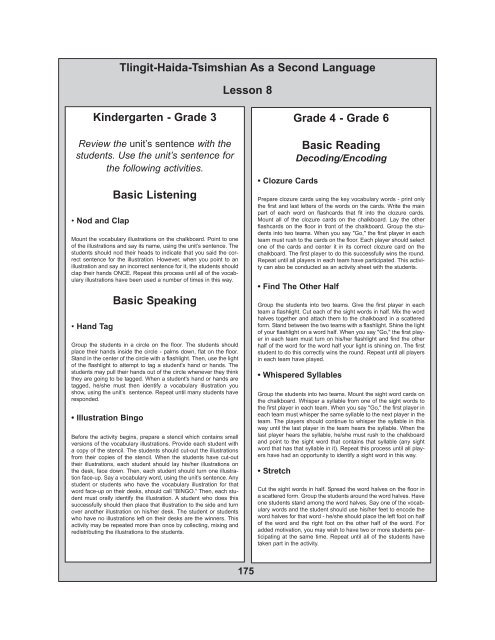Download - Sealaska Heritage Institute
Download - Sealaska Heritage Institute
Download - Sealaska Heritage Institute
You also want an ePaper? Increase the reach of your titles
YUMPU automatically turns print PDFs into web optimized ePapers that Google loves.
Tlingit-Haida-Tsimshian As a Second Language<br />
Lesson 8<br />
Kindergarten - Grade 3<br />
Review the unit’s sentence with the<br />
students. Use the unit’s sentence for<br />
the following activities.<br />
• Nod and Clap<br />
Basic Listening<br />
Mount the vocabulary illustrations on the chalkboard. Point to one<br />
of the illustra tions and say its name, using the unit’s sentence. The<br />
students should nod their heads to indicate that you said the correct<br />
sentence for the illustration. However, when you point to an<br />
illustration and say an incorrect sentence for it, the students should<br />
clap their hands ONCE. Repeat this process until all of the vocabulary<br />
illustrations have been used a number of times in this way.<br />
• Hand Tag<br />
Basic Speaking<br />
Group the students in a circle on the floor. The students should<br />
place their hands inside the circle - palms down, flat on the floor.<br />
Stand in the center of the circle with a flashlight. Then, use the light<br />
of the flashlight to attempt to tag a student's hand or hands. The<br />
stu dents may pull their hands out of the circle whenever they think<br />
they are going to be tagged. When a student's hand or hands are<br />
tagged, he/she must then iden tify a vocabulary illustration you<br />
show, using the unit’s sentence. Repeat until many students have<br />
responded.<br />
• Illustration Bingo<br />
Before the activity begins, prepare a stencil which contains small<br />
ver sions of the vocabulary illustrations. Provide each student with<br />
a copy of the stencil. The students should cut-out the illustrations<br />
from their copies of the stencil. When the students have cut-out<br />
their il lustrations, each student should lay his/her illustrations on<br />
the desk, face down. Then, each student should turn one illustration<br />
face-up. Say a vocabulary word, using the unit’s sentence. Any<br />
student or students who have the vocabulary illustration for that<br />
word face-up on their desks, should call “BINGO.” Then, each student<br />
must orally identify the il lustration. A stu dent who does this<br />
successfully should then place that illustration to the side and turn<br />
over another il lustration on his/her desk. The student or students<br />
who have no illustrations left on their desks are the win ners. This<br />
activity may be re peated more than once by collecting, mixing and<br />
redistributing the illustra tions to the students.<br />
• Clozure Cards<br />
Grade 4 - Grade 6<br />
Basic Reading<br />
Decoding/Encoding<br />
Prepare clozure cards using the key vocabulary words - print only<br />
the first and last letters of the words on the cards. Write the main<br />
part of each word on flashcards that fit into the clozure cards.<br />
Mount all of the clozure cards on the chalkboard. Lay the other<br />
flashcards on the floor in front of the chalkboard. Group the stu -<br />
dents into two teams. When you say "Go," the first player in each<br />
team must rush to the cards on the floor. Each player should select<br />
one of the cards and center it in its correct clozure card on the<br />
chalkboard. The first player to do this successfully wins the round.<br />
Repeat until all players in each team have partici pated. This activity<br />
can also be conducted as an activity sheet with the students.<br />
• Find The Other Half<br />
Group the students into two teams. Give the first player in each<br />
team a flashlight. Cut each of the sight words in half. Mix the word<br />
halves together and attach them to the chalkboard in a scattered<br />
form. Stand between the two teams with a flashlight. Shine the light<br />
of your flashlight on a word half. When you say "Go," the first player<br />
in each team must turn on his/her flashlight and find the other<br />
half of the word for the word half your light is shining on. The first<br />
student to do this correctly wins the round. Repeat until all players<br />
in each team have played.<br />
• Whispered Syllables<br />
Group the students into two teams. Mount the sight word cards on<br />
the chalkboard. Whisper a syllable from one of the sight words to<br />
the first player in each team. When you say "Go," the first player in<br />
each team must whisper the same syllable to the next player in the<br />
team. The players should continue to whisper the syllable in this<br />
way until the last player in the team hears the syllable. When the<br />
last player hears the syllable, he/she must rush to the chalkboard<br />
and point to the sight word that contains that syllable (any sight<br />
word that has that syllable in it). Repeat this process until all players<br />
have had an opportunity to identify a sight word in this way.<br />
• Stretch<br />
Cut the sight words in half. Spread the word halves on the floor in<br />
a scattered form. Group the students around the word halves. Have<br />
one students stand among the word halves. Say one of the vocabulary<br />
words and the student should use his/her feet to encode the<br />
word halves for that word - he/she should place the left foot on half<br />
of the word and the right foot on the other half of the word. For<br />
added motivation, you may wish to have two or more stu dents participating<br />
at the same time. Repeat until all of the stu dents have<br />
taken part in the activity.<br />
175
















